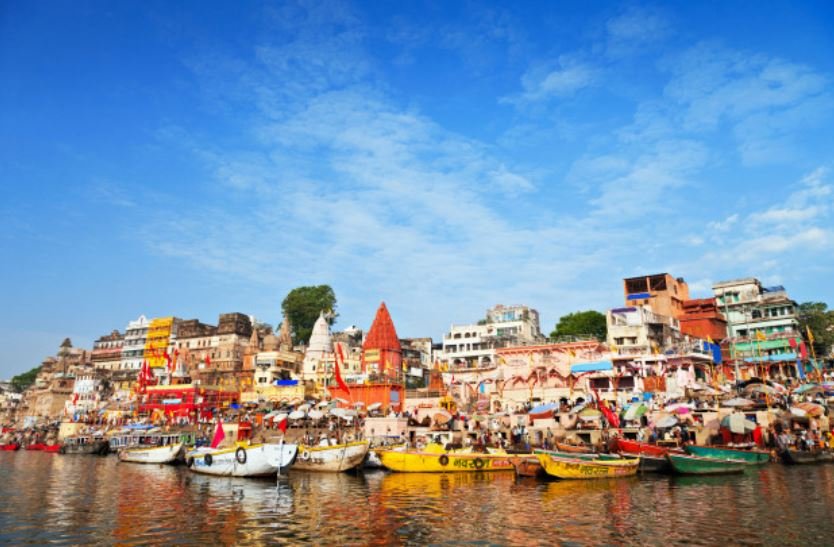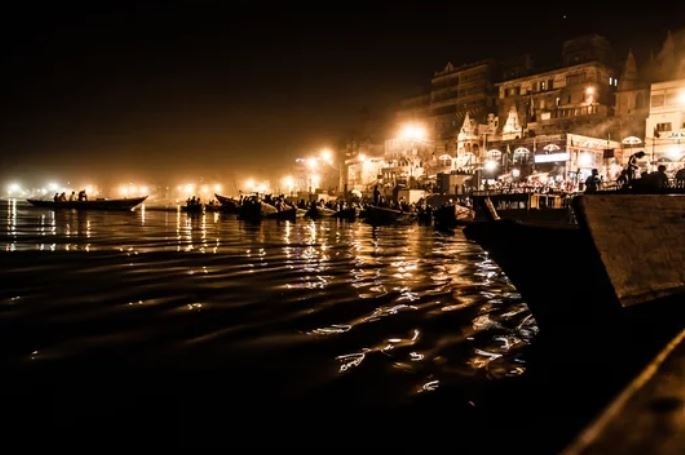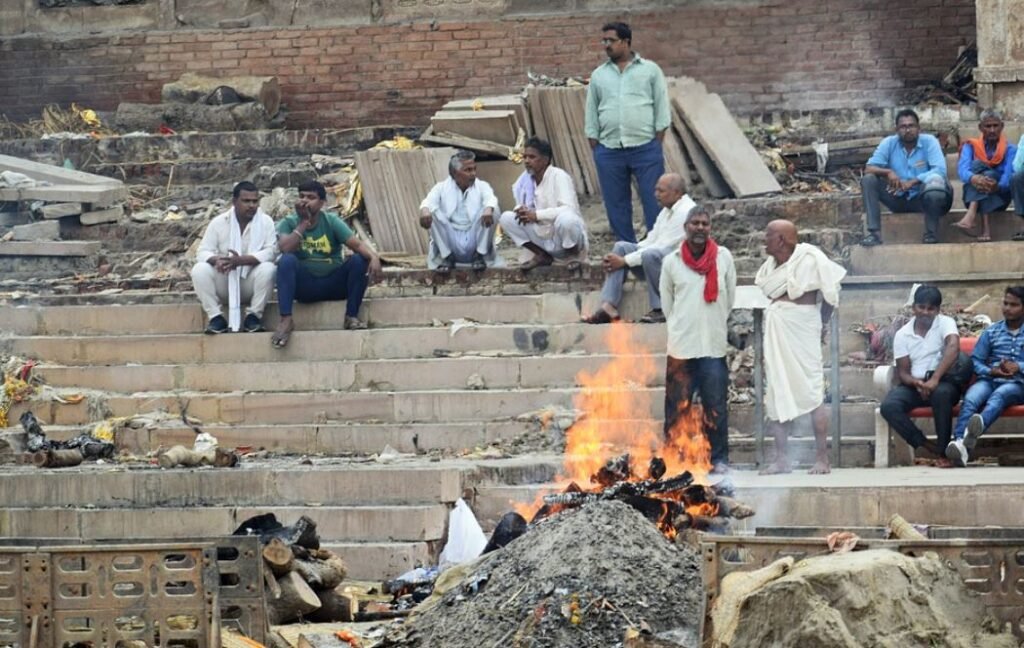Varanasi is surreal, so are its ghats. Better known as Kashi, Varanasi is one of the 7 holiest places for Hindus – one of Saptapuri. Legends say that Kashi lies on the tip of Trishul of Lord Shiva. And that He protects the city even during the time of Maha Pralaya.
This holiest city for Hindus and its ghats narrates many truths of life that are beyond a religious view. If you are planning for a trip to Varanasi, be prepared to experience the many mystical aspects that Varanasi ghats are ready to offer.
Quick Navigation
Benaras Ghats
Kashi is known for its Ghats as much as it is for Kashi Vishwanath temple, one of the richest temples in India. Ghats in Varanasi are embankments of the Ganga river with steps made of stone slabs. There are more than 84 ghats in Varanasi, each known for its legend and prominence. Some Ghats are cremation grounds, while some others take you into ancient and medieval times.
Varanasi is not a UNESCO-protected site. There are many privately owned ghats in Varanasi. Kings who ruled Varanasi built various ghats during their times. Being at the confluence of three holy rivers – Ganga, Yamuna, Brahmaputra – impart significance to Varanasi ghats. Boating at the ghats of Varanasi is one blissful activity anyone who is keen on understanding the real meaning of life should not miss.
History of Varanasi
Hindus believe that Varanasi is the most ancient city on Earth. Researchers cannot disagree with this.
Archeological evidence reveals that Varanasi dates back to 1800 BCE. According to Sadhguru, the renowned Indian philosopher and Guru, no one ever could decipher how ancient Varanasi is. The city existed and flourished even before Rome, Athens, or Jerusalem did. Sadguru also adds that philosophers from across the globe came in search of something mystical, and they found their answers in Varanasi.

Other names of Varanasi
Varanasi is a spiritual city located on the banks of the Ganges river in Uttar Pradesh, India. Varanasi is also called Benaras or Kashi, like many other Indian cities that have old and new names.
The name Varanasi originates from the names of two rivers – Varuna and Assi. The whole city lies on the banks of these two rivers. While Varuna is still flowing, Assi exists as a small stream near the Assi Ghat.
Rig Veda calls Varanasi by the name Kashi. The meaning of the word Kashi is – the place that gives enlightenment. Another name of Kashi, as per Vedas is Kashika, meaning a place that glows all the time.
The city is also known as Anandavana – the place where Lord Shiva resides in his blissful form.
Another name of the Benaras is Avimukta – means “a place that Lord Shiva never likes to forsake”.
India vs Bharat: The Significance of the Name Bharat
The magnificence of Ayodhya Ram Mandir

Significance of Varanasi
Ask a staunch Hindu or any philosopher in search of the real meaning of life the place they want to visit before they die. Don’t be surprised if the immediate reply would be the name of this holy city. This is because of the popular belief that dying in Varanasi is believed to free one from the unending pain of rebirth.
According to Hindu Mythology, Lord Shiva once chops off one of the five heads of Lord Brahma. He carries it all along with him as a mark of the victory. When he was walking through Kashi along with Brahma’s head, it fell onto the ground and disappeared into the Earth. This explain why Varanasi holds religious significance.
The Story of Varanasi Cricket Stadium
The magnificence of Ayodhya Ram Mandir
As per Sadhguru’s conversations, Kashi is one city that Lord Shiva is intensely in love with. He never feels like leaving the place. Lord Shiva is known for his love of simplicity and living along with his Ganas in the remote hilly mountains of Kailash. But he married Goddess Parvati, who is a princess. So, he moves to the plains to live along with his wife.
On the other hand, Gods want to add liveliness to the Varanasi. They worry if Shiva, who is known for his simplicity and mystic nature, would do it. So, they ask Divodasa, a tribal king as per Rig Veda, to become the King of Varanasi and work on this.
Divodasa already knows that people of Kashi love and adore Shiva very much. He requests Shiva to leave the place if he has to beautify the city as people will only listen to Shiva and not him despite being the King. Thus, Shiva moves along with Parvati to Mount Mandara. But his love towards Kashi never fades off; he always wanted to come back to Kashi.
The Celestial Power of Rama Nama
To achieve this, Lord Shiva sends celestial women, Lord Surya, Lord Brahma, and two of his ganas – one after the other to lure Divodasa into making a mistake, which they could use to dethrone him. Despite their lurings, no one could find even a single wrong in Diyodasa, for he never left the path of dharma. Interestingly, all of them who went to lure Diyodasa get attracted to the glory and charm of Kashi, settle there and never returned.
Surprised, Lord Shiva sent his child Ganesha along with another gana. Even these two realize that no one can ever leave Varanasi, and Lord Shiva would come here what may. So, they also settle there. They lure Divodasa saying that he would be gifted with Moksha if he leaves Varanasi for Lord Shiva.
Divodasa being the man of Dharma understands that the ultimate thing a human would get is Moksha. And he immediately agrees to the proposal happily. Thus, Lord Shiva comes again to Kashi and settles there.
The mention of the city Kashi can be found in Mahabharata and Vedas.
ततो वाराणसीं गत्वा अर्चयित्वा वृषभध्वजम् ।
कपिलाहृदे नरः स्नत्वा राजसूयमवाप्नुयात् ।।
अविमुक्तं समासाद्य तीर्थसेवी कुरुद्वह ।
दर्शनाद् देवदेवस्य मुच्यते ब्रह्महत्यया ।।
प्राणानुत्सृज्य तत्रैव मोक्षं प्राप्नोती मानवः ।।
Brief Meaning: One who gives away their prana (life) in Varanasi would obtain Moksha.
Varanasi is also the venue of the meeting place of Lord Rama with his brother Bharata after 14 years of exile. Even today, the ghats in Varanasi celebrate the event with the name “ Bharat Milap”, meaning the meet of Bharat with Ram. This event takes place during the Dusshera season every year.
Sadguru shares that Varanasi has as many as 72,000 shrines. Interestingly, this is also the number of nadis or nerves in the human body. The city connects one with their own human body, he says. Maybe this is why anyone who visits the city would never feel like returning, as is clear from the story above.

Cultural significance of Varanasi
Varanasi is immensely prominent for Hindus. They would even want to die in this place. Interestingly, the city is a home for a huge number of Muslims too. When India was in the hands of Mughal rulers, Kashi witnessed immense popularity.
Mughal rulers, including King Akbar, patronized the city and built temples for Lord Shiva and Lord Vishnu. The city enjoyed Maratha dynasty rule from 1737 to 1947. Currently, there are 15 mosques in Kashi that are of immense prominence to Muslims. Alamgiri mosque is one famous mosque of Varanasi.
Along with being the place to behold the Ganga Aarti and Shivaratri – the two most prominent events for Hindus, Varanasi is also a place where one should witness Ramzan and other Islam festivals.
Varanasi is of utmost significance for Buddhists too. Gautama Buddha found Buddhism in Varanasi. It is near Sarnath stupa that he delivered his first sermon – The Setting in Motion of Wheel of Dharma.
Jainism, too, has many relations with Varanasi. There are three Jain mandirs in Varanasi, while many renowned ghats derive their names from prominent Jain personalities.

History of Kashi Vishwanath Temple
The Kashi Vishwanath temple is the core of Varanasi. Lord Shiva is worshipped here in the name of Vishwanath, meaning the protector of the Universe. Kashi Shiv Linga is one of the most powerful forms of Lord Shiva as per Hindu beliefs. The temple draws millions of devotees every year.
The temple witnessed several invasions and reconstructions. Aurangazeb destroyed the major part of the original Kashi Vishwanath temple and built the Gyanvapi mosque. The present temple adjacent to the mosque was built in 1780 by Ahilyabai Holkar, the daughter-in-law of the Maratha ruler Malhar Rao.
Kashi Krama
It is a spiritual walk across the streets of Varanasi in a preset manner. The walk covers all temples in Kashi and gives a complete spiritual experience of visiting Kashi.

Famous Ghats in Varanasi
Most ghats in Varanasi are built during the Maratha empire. There are tens of ghats in Varanasi. However, some are mystically lively and fascinatingly tell many stories.
Assi Ghat
The first Ganga ghat in Benaras, Assi Ghat wakes up to the morning aartis like no other. Assi ghat lies beside the river Assi and here is where Assi joins the Ganges. According to Hindu mythology, the Assi river originated when Goddess Durga’s sword struck the ground when she was killing demons Shumbha and Nishumbha.
Every morning around 300 people gather here to witness the divine aarti at this Ganga ghat. During the days of significance like Sivaratri or Dusshera, the count reaches thousands. The ghat lies at the southern corner of the city. The Shiva Linga beneath the fig tree here on this Ganga ghat is considered very sacred. Just sit on this Ganga ghat and watch the Ganga aarti to lose into another blissful world of spiritualism.
Dasaswamedh Ghat
The liveliest ghat in Varanasi, Dasaswamedh Ghat is where you have to be present by around 5 PM. The Agni Puja (Worship of Fire) starts around 7 PM. So, to catch the close-up look of the aarti – the eternal flames, and the mystical beauty of the aarti ritual, you should be present a little earlier to beat the rush and gain your spot.
Dasaswamedh Ghat is the oldest ghats in Varanasi. Legends say that Lord Brahma himself created this ghat. The name Dasaswamedh comes from the fact that Lord Brahma sacrificed ten horses here as a part of the ritual.
You can spend on full day sitting on this ghat doing nothing but see the people, their faith, the Sadhus, as well as the burning pyres!
What is Hanuman Jayanthi? What is the importance of Hanuman Jayanthi?
Manikarnika Ghat
In Sanskrit, Manikarnika means an earring with a precious jewel. The name of the Manikarnika ghat arises from an interesting story. Once Goddess Parvati dropped her earrings at this place on the order of Lord Shiva. The earrings fall deep into the Earth.
Lord Vishnu offers his help to his sister Parvati to find her earrings. He tries intensely digging the soil but could not find them. He sweats so much that the place fills with his sweat. Looking at his hard work, Lord Shiva says to Vishnu – “the whole town of Kashi is mine, but this place is yours since you put your hard work and sweat“.
Hindus believe that one should live in Manikarnika ghat in their last days to understand life’s essence. The ghat, popular for the number of dead bodies cremated here, is one famous ghat in Varanasi.
Around 100 dead bodies are burnt daily at Manikarnika ghat. This ghat is also called Mahasmasana – the eternal graveyard. According to beliefs, when cremation stops at Manikarnika ghat, the world would come to an end. People bring the dead bodies of their beloved to this ghat with a belief that cremating here will emancipate them from their death and rebirth cycle.
As per religious beliefs, when one dies, the pranic force leaves the body causing immense pain in every nerve. Manikarnika ghat as well as the whole of Kashi smoothen this experience with the mystical power they hold. The place helps the soul in leaving the body with grace and little pain. This explains why every spiritual person would wish to die in Varanasi!
Digpatia ghat
This Ganga ghat reflects Bengali architecture. The Digpatia ghat is famous for the yogini temples. Out of the 64 yogini images which are considered sacred, 16 are present in Varanasi. Devotees visit the Kali temple on this ghat in huge numbers on auspicious days like Holi and Dusshera.
Jain Ghat
The birthplace of 7th Thirthankara, Suparshvanatha, Jain ghat holds prominence as per Jainism. This ghat is also called Bachraj Ghat. There are three Jain temples on this Ganga ghat, all built during the Jain Maharajas era.
Harischandra Ghat
This is another oldest ghats in Varanasi. It is also called Adi Manikarnika ghat. Its name originates from the legend that King Harishschandra, known for his adherence to truth, worked as a cremator here.
Harischandra ghat is another ghat that is of immense religious significance. Burning the dead bodies here is believed to relieve the person from rebirth. This is yet another Benaras ghat that tells you how temporary life can be.

Manmandir Ghat
This ghat has famous temples such as Rameshwara, Someshwara, and Sthuladanata Vinayaka. Located on the north of Benaras, this ghat reflects the construction style of Jaipur kings.
Narad Ghat
Named after the Hindu god Narad, this ghat is not for couples! It is believed that couples should not bath here because it might lead to trouble in their relation, thanks to the witty and trouble-making nature of Narad.
Kedar Ghat
This Ganga ghat is believed to have miraculous water that can cure diseases. The ghat is also famous for the Kedar temple. Devotees believe that visiting this temple is equivalent to visiting the Kedarnath temple in Uttarakhand.
Interesting facts about Varanasi
- Varanasi is the home of Benaras Hindu University, the only educational institution that offers a course in Vedas.
- Renowned artists and musicians such as Pandit Ravi Shankar, Sitara Devi, Gopi Krishna, and Ustad Bismillah Khan gain their inspiration from the Ganges and the serenity of this holy city.
- Benaras Silk – the handicraft of this city is world-renowned. World-renowned for its intricate designs of zari and silk threads, Benaras silk weaving is the main occupation of Muslims in Varanasi. These sarees are known for their grandeur and cultural significance.
- Kashi is the only place on Earth to have so many embankments beside a river.
- Varanasi has three to five layers of city. This is proof that the city has been rebuilding itself over time since the formation of Earth. This fact looks like support to the statement from Mahabharatha.
ब्रह्मणश्च दिने सा हि न विनश्यति निश्चितम्।
तदा शिवस्त्रिशूलेन दधाति मुनयश्च ताम्।। २३ ।।
Even after Brahma’s divine day gets completed (Kalpa), the city of Kashi does not get destroyed. At that instant, oh sages, Siva holds it over the tip of his trident.
पुनश्च ब्रह्मणा सृष्टौ कृतायां स्थाप्यते द्विजाः ।
कर्मणां कर्षणाचैव काशीति परिपठ्यते॥ २४॥
O scholars, when Brahmā again recreates the universe, then he again builds Kashi.
- Tulsidas wrote the famous Rama Charita Manas in Varanasi. Another scripture Manusmirti by Kulluka Bhat was also composed here.
- Ganga Mahotsav (Nov-Dec), Sivaratri (Feb-Mar), Hanuman Jayanthi (Apr), Dusshera (Sep-Oct), Kartika Pournami (Oct-Nov) are the major Hindu festivals that one should experience in Varanasi.
- The cost of living is less in Varanasi. For as low as Rs.450, one can find good accommodation nearby the banks of the Ganges.

What to know before you visit Varanasi
Varanasi is not a place for those who want to enjoy a commercial vacation. This holy place pushes you to witness the truth of life hidden in your soul, taking you away from the materialistic attractions. The never-ending sights of burning pyres and dead bodies will create one sense of detachment towards life.
Like any town that has been far away from commercialization, Varanasi still holds the spiritual vibes. The streets may be dirty, and the rush may be huge. The Ganges may appear polluted. But, be prepared to look beyond all these to realize your true meaning of life.
When you are visiting Kashi, spend some time meditating on these Ganga ghats. Introspect as you enjoy the fresh breeze of the Ganges and witness the Maha Aarti. The surreal view of divine lamps of Ganga aarti will give you another perspective of how nightlife can be.
The holy place takes you to journey deep within into yourself. Be prepared to experience Smasana Vairagya (the fact that life is uncertain) at its peak as you plan to visit Varanasi. Because, this is what exactly Varanasi wants to teach every one of us – Life is temporary, Moksha is eternal.
About the Author:
Swetha Prasanna Gangavarapu is enthused with the beauty of Hinduism. She is an avid traveler and loves experiencing the tranquility of temples as and when possible. She is a Content Director, Marketer and Senior Freelance Content Writer and reachable on LinkedIn.
Swetha is a Content Specialist, LinkedIn Branding and B2B Marketing Consultant. When she is not in the world of B2B, she researches the roots and beauty of Indian Culture and Traditions. She is the author of the book: 365 Days 365 Posts – The Guide to LinkedIn Personal Branding, available exclusively on Amazon. Connect with her on LinkedIn.

